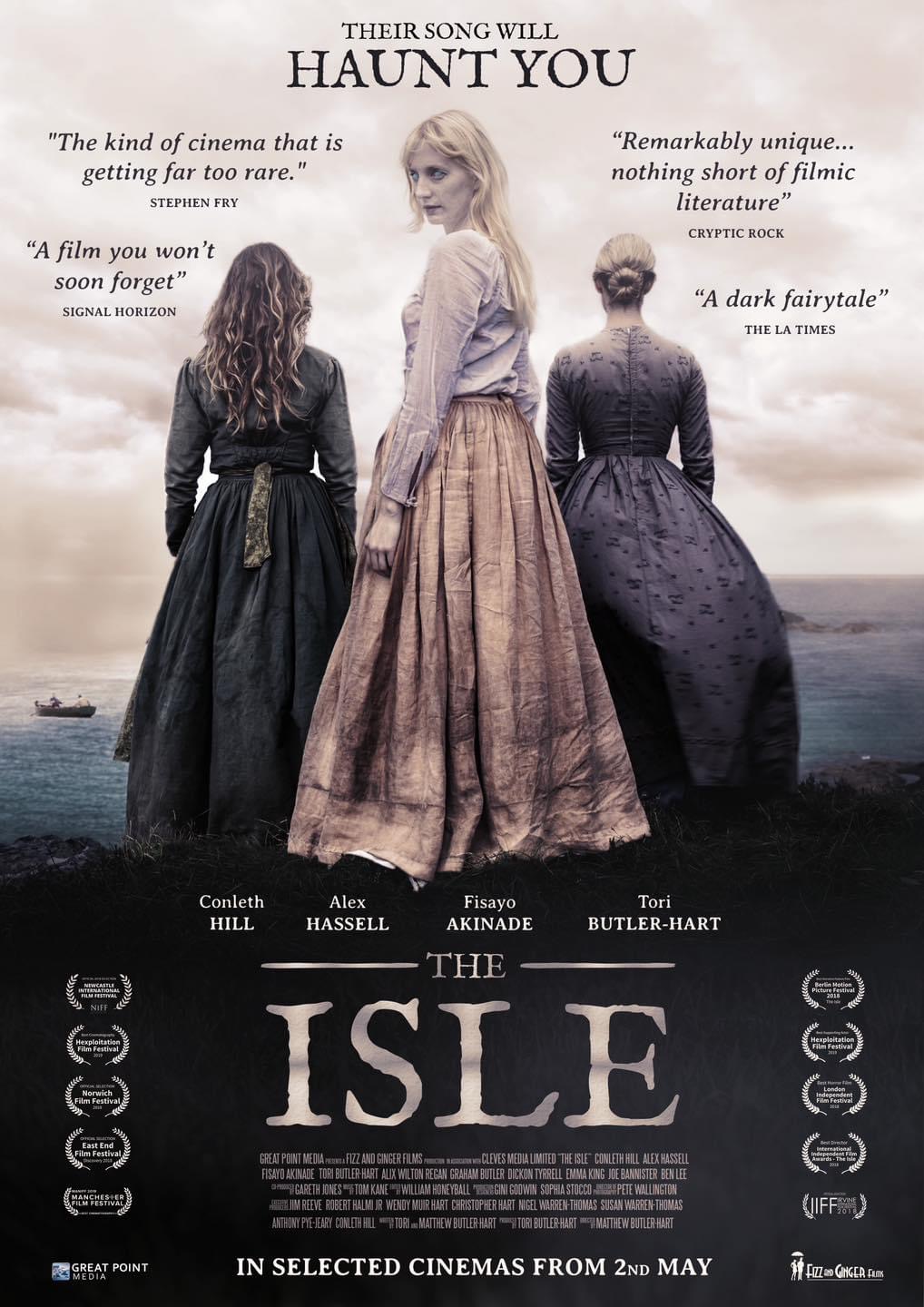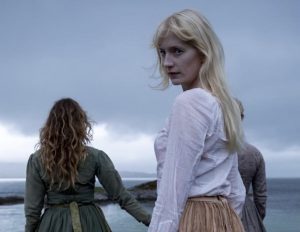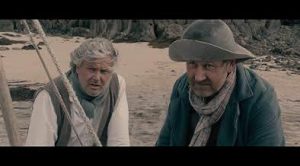The Isle (2018)

The Isle (2018) is a haunting and atmospheric supernatural thriller that merges elements of horror, folklore, and historical drama. Directed by Matthew Butler-Hart and set in 1846, the film tells the story of three shipwrecked sailors who find themselves stranded on a remote Scottish island populated by only a few mysterious inhabitants. As the sailors attempt to uncover the secrets of the island and find a way to escape, they are drawn into a chilling tale of ancient curses, tragedy, and supernatural forces. While The Isle embraces a slow-burn storytelling approach, it builds tension with a captivating sense of atmosphere and foreboding.
Suggested videos for you:
Setting and Atmosphere
One of The Isle’s most compelling aspects is its setting. The filmmakers make excellent use of the Scottish coast and landscape, emphasizing the rugged beauty and inherent isolation of the location. The island feels desolate and eerie, with thick fog, rocky shorelines, and abandoned buildings creating an environment that feels both haunting and beautiful. The sense of isolation adds to the tension, as the characters and audience are trapped in a space that feels cut off from the rest of the world. The cinematography captures the haunting landscape in a way that immerses the viewer, making the island itself feel like a character—a silent, looming presence filled with secrets.
This isolation is enhanced by the sparse cast, as there are only four residents on the island when the sailors arrive. The silence and emptiness of the place add to the unsettling atmosphere, as though something is lurking just beyond the mist. The visual elements are understated yet powerful, evoking a strong sense of Gothic horror without relying on heavy-handed visual effects or over-the-top scares.
Plot and Pacing
The story follows three sailors—Oliver, Jim, and Cailean—who survive a shipwreck and are guided to safety by the strange island residents. At first, the inhabitants—Douglas, Fingal, and the elusive Lanthe—seem harmless but distant, unwilling to engage fully with the strangers or reveal much about the island. As the sailors settle in and search for a way to leave, they begin to experience strange visions and uncover hints of a tragic past. Mysterious figures appear in the fog, and whispers of a long-lost woman seem to echo through the night, suggesting that the island harbors a dark history.
The pacing of The Isle is intentionally slow, allowing suspense to build gradually. While this approach creates an immersive experience for those willing to invest in its subtleties, it might feel sluggish to viewers expecting a faster, jump-scare-filled horror film. Instead, The Isle leans into its slow-burn mystery, with tension coming from unanswered questions and an increasing sense of dread. The sailors find clues and snippets of the island’s history, leading to the revelation of a tragic love story, betrayal, and a supernatural curse that lingers over the land. The gradual unspooling of the island’s past adds layers to the story and keeps the audience invested as they piece together the mystery alongside the characters.
Themes and Folklore
The film delves deeply into themes of grief, guilt, and retribution, drawing heavily from Scottish folklore. The Isle doesn’t rely on conventional horror tropes; rather, it explores the psychological impact of isolation and supernatural belief. The island’s history is steeped in tragedy, and the haunting figures are more than mere ghosts—they represent unresolved pain and the price of betrayal. This theme is embodied by the character of Lanthe, who becomes a ghostly presence bound to the island by a curse tied to past wrongdoings.
Through the lens of folklore, the film explores the idea of spirits that haunt not because they seek revenge but because they cannot find peace. The ghostly encounters have an almost dreamlike quality, more melancholy than terrifying. This choice differentiates The Isle from more mainstream horror films, adding a layer of poignancy to the supernatural elements and grounding the horror in emotional trauma. The curse serves as a metaphor for how the island’s residents—and by extension, the sailors—are trapped by their own guilt and regret.
Characters and Performances
The cast delivers strong, understated performances that suit the film’s subdued tone. Conleth Hill (best known for his role as Varys in Game of Thrones) portrays Douglas, the unofficial leader of the island’s inhabitants, with a quiet intensity that hints at buried secrets. Alex Hassell and Fisayo Akinade play the sailors Oliver and Jim, respectively, while Alix Wilton Regan portrays the ethereal Lanthe. Each actor brings a grounded, naturalistic style to their roles, helping to emphasize the film’s tone of restrained horror.
The film focuses more on atmosphere and mystery than on character development, yet each character feels distinct and adds to the overall sense of unease. Douglas and Fingal, the two remaining islanders, exude a strange blend of friendliness and wariness, as though they are caught between wanting to help the sailors and hiding from them. Their hesitation is infectious, making the audience question their motives and adding to the suspense.
The sailors’ interactions with the islanders grow increasingly strained as they realize that something is amiss. The subtle tension in these scenes, where politeness masks fear and mistrust, underscores the island’s foreboding atmosphere. Lanthe, the ghostly woman tied to the island, is portrayed with a haunting presence by Wilton Regan. Her appearances are sparse but impactful, adding an otherworldly quality that heightens the tension.
Cinematography and Sound Design
The cinematography in The Isle enhances the film’s quiet horror. The fog-covered landscapes, the dilapidated stone buildings, and the vast ocean surrounding the island all contribute to an atmosphere of desolation and entrapment. Director of photography Sarah Deane captures each frame with a painterly quality, using natural light and shadow to evoke a sense of mystery. The visual elements work in tandem with the sound design, which is minimalistic but effective. Eerie silences, the sound of the ocean, and the faint whispers in the background add layers of suspense without relying on jump scares or heavy music cues.
The film’s soundscape also includes haunting music that accentuates the melancholic tone of the ghost story. The musical score, composed by Keaton Henson, is soft and eerie, enhancing the atmosphere without overwhelming the scenes. The sound of wind, waves, and footsteps in the empty village underscores the isolation and suspense. Silence is often used to great effect, allowing the island’s natural sounds to heighten the tension and create a feeling of unease.
Conclusion
The Isle is a thoughtful, atmospheric horror film that leans more into psychological and supernatural dread than explicit scares. It requires patience, as it unfolds slowly, revealing its secrets one layer at a time. While this slow pace may not be for everyone, it allows the film to develop a rich, immersive experience that draws viewers into the island’s haunting world. The film’s strengths lie in its setting, atmosphere, and unique approach to folklore-driven horror, making it a rewarding watch for fans of gothic horror and supernatural mysteries.
For those seeking traditional horror with intense scares and action, The Isle might feel underwhelming. However, for viewers willing to engage with a meditative, melancholic ghost story, the film offers a rewarding experience. It’s a rare type of horror film that explores the haunting legacy of grief, the weight of isolation, and the power of unresolved memories, all while maintaining a quiet, ghostly beauty. The Isle lingers long after the credits roll, leaving a sense of unease and melancholy that resonates with the core of its story—a tale of spirits bound to the past, caught in an eternal cycle of grief and remembrance.










